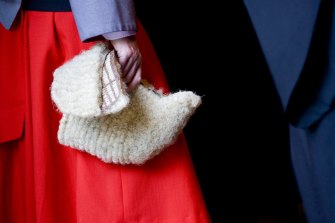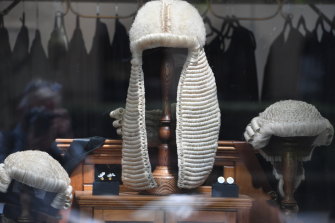A few years ago, I was in the city with my preschool kids when we saw a line of judges on their way to a judicial ceremony, all dressed in full wigs and flowing scarlet robes.
“Wow! Look at all the Santas!” they cried.
The wig may become a thing of the past.Credit:Jessica Shapiro
At last wigs are finally fading away like so many 19th-century sepia photographs. But the tradition goes back much farther than that.
The gowns are black to mark the 1714 death of Queen Anne. Surely after 307 years we have done enough grieving.
Wigs became fashionable in London with the return of Charles II from Europe in 1660 and the restoration of the monarchy. They conveniently covered up the baldness that was one of the signs of syphilis and were originally made from human hair, often cut from cadavers. Today’s horsehair makes a pleasant change.
It’s now five years since the Victorian Supreme Court stopped judges and barristers wearing wigs. In the County Court it’s up to the individual judge, and then barristers follow that lead. But there are fewer and fewer clinging to tradition.
Those who do, say that wigs are vital because they provide anonymity and emphasise that barristers are independent, fighting for their client. The focus is squarely on the argument alone. Then again, if you need a wig to win your case you just might need a better lawyer.
Others argue that wigs bring a solemnity and dignity to proceedings. And besides, a crumpled robe and battered wig bring a certain raffish élan.
But by that argument, there must be no gravitas in the Federal Court of Australia where wigs are never worn.
I don’t want to ditch tradition just for the hell of it. And I’m all for the non-conformists at the Bar with their louche Rumpolian charm.
A full-bottomed wig, worn by Queen’s Counsels in NSW.Credit:Peter Rae
But let’s face it, wigs belong in an era when people took a pinch of snuff and then went off to watch the bear baiting. Their time is over.
Robes are a different matter. Some women barristers believe keeping them would stop their appearances and their style of dress forever being under the patriarchal microscope.
For example, in 1987, Ariel Couchman (now director of Youthlaw in Carlton) caused multiple apoplexies among senior Supreme Court judges when she turned up to be admitted as a solicitor dressed in pants. So much for wigs and gowns being a cornerstone of justice.
Today we funnel so many of our best and brightest into law schools and then on to large firms and the Bar to work for the rich and powerful. Meanwhile our prisons are crammed with the poor and dispossessed.
We are over-lawyered but under-represented. In that context, wigs, symbols of unfettered wealth and power, are not delightfully eccentric anachronisms; they represent everything that’s wrong with law and justice in Australia today.
Duncan Fine is a lawyer and regular columnist.
Most Viewed in National
From our partners
Source: Read Full Article


